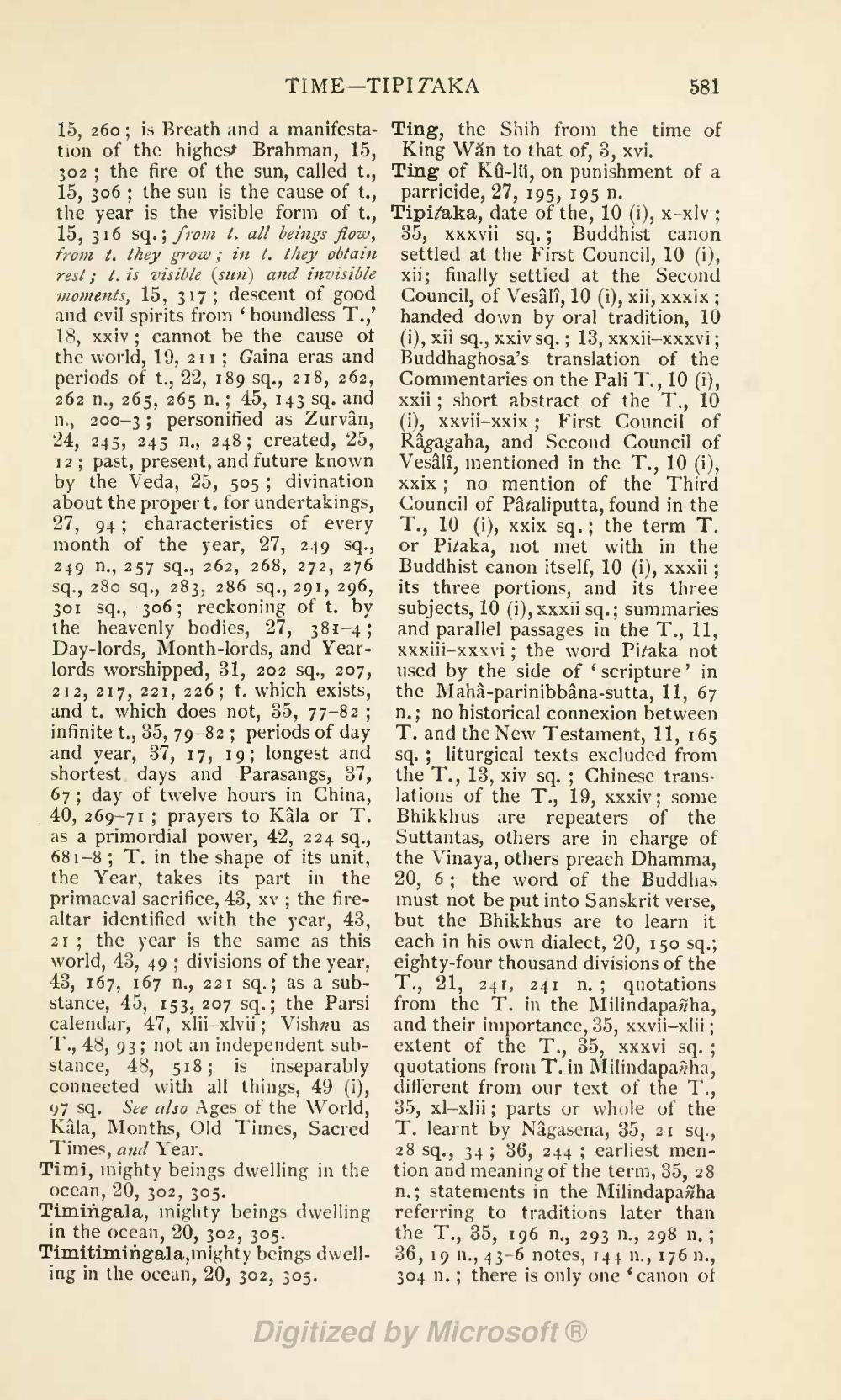________________
TIME-TIPITAKA
581
Ting, the Shih from the time of King Wăn to that of, 3, xvi. Ting of Kû-lii, on punishment of a parricide, 27, 195, 195 n. Tipitaka, date of the, 10 (i), x-xlv; 35, xxxvii sq.; Buddhist canon settled at the First Council, 10 (i), xii; finally settied at the Second Council, of Vesâlî, 10 (i), xii, xxxix; handed down by oral tradition, 10 (i), xii sq., xxiv sq.; 13, xxxii-xxxvi; Buddhaghosa's translation of the Commentaries on the Pali T., 10 (i), xxii; short abstract of the T., 10 (i), xxvii-xxix; First Council of Râgagaha, and Second Council of Vesâlî, mentioned in the T., 10 (i), xxix ; no mention of the Third Council of Pâtaliputta, found in the T., 10 (i), xxix sq.; the term T. or Pitaka, not met with in the Buddhist canon itself, 10 (i), xxxii; its three portions, and its three subjects, 10 (i), xxxii sq.; summaries and parallel passages in the T., 11, xxxiii-xxxvi; the word Pitaka not used by the side of 'scripture' in the Mahâ-parinibbâna-sutta, 11, 67 n.; no historical connexion between T. and the New Testament, 11, 165 sq.; liturgical texts excluded from the T., 13, xiv sq.; Chinese translations of the T., 19, xxxiv; some Bhikkhus are repeaters of the Suttantas, others are in charge of the Vinaya, others preach Dhamma, 20, 6; the word of the Buddhas must not be put into Sanskrit verse, but the Bhikkhus are to learn it each in his own dialect, 20, 150 sq.; eighty-four thousand divisions of the T., 21, 241, 241 n.; quotations from the T. in the Milindapanha, and their importance, 35, xxvii-xlii; extent of the T., 35, xxxvi sq.; quotations from T. in Milindapanha, different from our text of the T., 35, xl-xlii; parts or whole of the T. learnt by Nâgasena, 35, 21 sq., 28 sq., 34; 36, 244; earliest mention and meaning of the term, 35, 28 n.; statements in the Milindapazha referring to traditions later than the T., 35, 196 n., 293 n., 298 n.; 36, 19 n., 43-6 notes, 144 h., 176 n., 304 n.; there is only one 'canon of
15, 260; is Breath and a manifestation of the highest Brahman, 15, 302; the fire of the sun, called t., 15, 306; the sun is the cause of t., the year is the visible form of t., 15, 316 sq.; from t. all beings flow, from t. they grow; in t. they obtain rest; t. is visible (sun) and invisible moments, 15, 317; descent of good and evil spirits from 'boundless T.,' 18, xxiv; cannot be the cause of the world, 19, 211; Gaina eras and periods of t., 22, 189 sq., 218, 262, 262 n., 265, 265 n.; 45, 143 sq. and 11., 200-3; personified as Zurvân, 24, 245, 245 n., 248; created, 25, 12; past, present, and future known by the Veda, 25, 505; divination about the proper t. for undertakings, 27, 94; characteristics of every month of the year, 27, 249 sq., 249 n., 257 sq., 262, 268, 272, 276 sq., 280 sq., 283, 286 sq., 291, 296, 301 sq., 306; reckoning of t. by the heavenly bodies, 27, 381-4; Day-lords, Month-lords, and Yearlords worshipped, 31, 202 sq., 207, 212, 217, 221, 226; t. which exists, and t. which does not, 35, 77-82; infinite t., 35, 79-82; periods of day and year, 37, 17, 19; longest and shortest days and Parasangs, 37, 67; day of twelve hours in China, 40, 269-71; prayers to Kâla or T. as a primordial power, 42, 224 sq., 681-8; T. in the shape of its unit, the Year, takes its part in the primaeval sacrifice, 43, xv; the firealtar identified with the year, 43, 21; the year is the same as this world, 43, 49; divisions of the year, 43, 167, 167 n., 221 sq.; as a substance, 45, 153, 207 sq.; the Parsi calendar, 47, xlii-xlvii; Vishnu as T., 48, 93; not an independent substance, 48, 518; is inseparably connected with all things, 49 (i), 97 sq. See also Ages of the World, Kâla, Months, Old Times, Sacred Times, and Year. Timi, mighty beings dwelling in the ocean, 20, 302, 305. Timingala, mighty beings dwelling
in the ocean, 20, 302, 305. Timitimingala,mighty beings dwelling in the ocean, 20, 302, 305.
Digitized by Microsoft®




